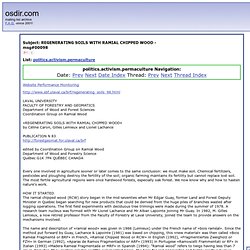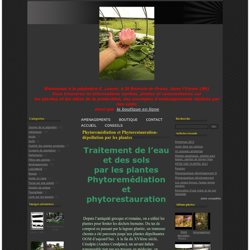

Phytoépuration. REGENERATING SOILS WITH RAMIAL CHIPPED WOOD. LAVAL UNIVERSITY FACULTY OF FORESTRY AND GEOMATICS Department of Wood and Forest Sciences Coordination Group on Ramial Wood «REGENERATING SOILS WITH RAMIAL CHIPPED WOOD» by Céline Caron, Gilles Lemieux and Lionel Lachance PUBLICATION N edited by Coordination Group on Ramial Wood Department of Wood and Forestry Science Québec G1K 7P4 QUÉBEC CANADA Every one involved in agriculture sooner or later comes to the same conclusion: we must make soil.

Chemical fertilizers, pesticides and ploughing destroy the fertility of the soil; organic farming maintains its fertility but cannot replace lost soil. HOW IT STARTED The ramial chipped wood (RCW) story began in the mid-seventies when Mr Edgar Guay, former Land and Forest Deputy Minister in Quebec began searching for new products that could be derived from the huge piles of branches wasted after logging operations. The name and description of «ramial wood» was given in 1986 (Lemieux) under the French name of «bois raméal». Jardiner au naturel.pdf. Le compost est fini ! Maintenant que le processus de compostage est terminé il faut le récolter et . . . l'utiliser.

Il est important que le compost soit "mûr" pour de l'utiliser. Un compost que n'est pas arrivé à maturité suffisante peut éventuellement être utilisé au pied d'arbres adultes mais certainement pas sur le potager ou avec des jeures arbres ou arbustres, il risquerait de "brûler" vos plantes. Comment reconnaître un compost mûr ? Il y a 3 caractéristiques qui ne trompent pas : S'il vous semble que votre compost stagne dans son état, sans arriver à maturité, n'hésitez pas à le re-mélanger afin de relancer le processus ! Comme nous l'avons vu, ce sont les macro-organismes (principalement les vers de compost) qui terminent la maturation.
Phytoremédiation et Phytorestauration-dépollution par les plantes - La pépinière aquatique. Traitement de l’eau et des sols par les plantes Phytoremédiation et phytorestauration Depuis l’antiquité grecque et romaine, on a utilisé les plantes pour limiter les déchets humains.

Du tas de compost en passant par la lagune plantée, un immense chemin a été parcouru jusqu’aux plantes dépolluantes OGM d’aujourd’hui. A la fin du XVIème siècle, Césalpin (Andrea Cesalpino), un savant italien remarquable tant par ses travaux en médecine, en philosophie, qu’en botanique découvre une plante dont il remarque qu’elle pousse dans des roches particulièrement riche en métaux, Alyssum bertolonii dont il n’imagine pas qu’elle sera étudiée durant 130 ans, jusqu’en 1948 pour sa capacité d’accumulation des métaux lourds dans ses tissus, et ce en plus grande concentration que dans le sol où elle croît. . ( voir aussi l'article " lagunage ") Pee all and end all: Nepal posits new approach to the compost question. Dung and dusted … A Nepalese man carries compost in the village of Khokana, on Kathmandu's outskirts.

Photograph: Prakash Mathema/AFP/Getty Images Human urine is superior to urea, a common nitrogen-rich mineral fertiliser, according to the results of a study carried out in a farmer's field outside Nepal's capital city. Researchers who tested the effects of applying different combinations of urine, compost and urea on sweet pepper, Capsicum annuum, found that urine synergises best with compost.
Urine for the study was sourced from mobile public toilets in the city and compost prepared from cattle manure. Results of the study, published in Scientia Horticulturae, showed that urine-compost mixtures produced the tallest plants and bore the most fruit. A "synergistic effect" was attributed to several factors including reduced nitrogen loss and enhanced availability of organic carbon in the soil. Next Big Future: Biochar could boost agricultural yields and control pollution.
Across the United States, sales of biochar, a long-lasting soil additive, have surged over the past few years.

Biochar sales have tripled annually since 2008, according to some estimates. The Biochar Company in Berwyn, Pennsylvania — which supplied Flanner's Brooklyn farm — sells it both wholesale and direct to consumers, through outlets including Amazon and some Whole Foods stores. And countries ranging from China to Sweden are using biochar on agricultural fields and city lawns. Proponents see big potential for the soil enhancer, which is produced by heating biological material — such as husks and other agricultural waste — in a low-oxygen chamber.
Biochar can be made as a by-product of biofuel generation, so some companies are hoping to cash in on both products as demand grows for greener forms of energy. Interest in biochar is also growing among scientists, who are quickly ramping up studies to test its potential. But not all studies show biochar to be a wonder material. Je dépollue les sols grâce aux plantes. Lombricompostage. Depollution des sols par les plantes. Plantes dépolluantes.